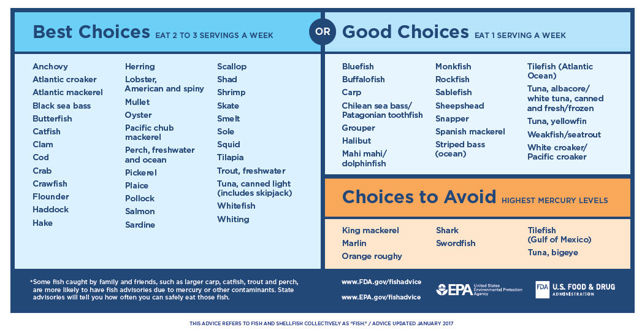Fish and seafood are an important part of a healthy diet. Fish and shellfish, collectively referred to as fish, contain high-quality protein and other essential nutrients, are low in saturated fat, and contain omega-3 fatty acids. You should eat 8 to 12 ounces of a variety of fish every week from choices that are lower in mercury and high in omega-3 fatty acids. The nutritional value of fish and seafood is important during growth and development before birth, in early infancy for breastfed infants, in childhood, and in adults.
Women who are pregnant might become pregnant, are breastfeeding, and young children should consume fish based on 3 categories:
-
Best Choices
-
Good Choices
-
Fish to Avoid
- Eat 8-12 ounces (2-3 servings) of a variety of fish a week from the “Best Choices” list OR 1 serving from the “Good Choices” list
- The “Best Choices” have the lowest levels of mercury
- A serving for an adult is 4 ounces
- The “Fish to Avoid” list includes 7 types of fish that typically have higher mercury levels
- Tilefish from the Gulf of Mexico, shark, swordfish, orange roughy, bigeye tuna, marlin, and king mackerel
- For young children, 1-2 servings of fish a week starting at age 2
- Serving sizes should be smaller and adjusted for age and total calorie needs.
- A serving for children aged 4-7 is 2 ounces
- When eating fish you or others have caught from streams, rivers, and lakes, pay attention to fish advisories on those water bodies. Please check the table below for species and sizes of fish from South Dakota bodies of water where limited consumption is advised.
- If advice isn't available, eat only one serving and no other fish that week.
- Clean and trim fish of fat and skin, since locally caught fish may contain contaminants besides mercury that can be reduced by proper trimming and cooking (e.g. broiling instead of frying can reduce some contaminants by letting fat drip away from the fish).
Find more details on mercury and fish consumption FAQ.

Consumption Advisories for South Dakota Rivers and Lakes
Fish from South Dakota lakes and rivers are tested for metals, pesticides, and PCBs as a collaborative effort of the South Dakota Departments of Game, Fish & Parks, Agriculture & Natural Resources, and Health. Please check the table below for species and sizes of fish from South Dakota bodies of water where limited consumption is advised.
Read a complete table of water bodies tested in SD
Current Mercury Fish Consumption Advisories
For more information, contact:
Aaron Leingang, SD Dept. of Agriculture and Natural Resources, 605-773-3351
John Lott, SD Dept. of Game, Fish & Parks, 605-773-4508
John Osburn, SD Dept. of Health, 605-394-6064
Press Releases
South Dakota Department of Health Issues New Fish Consumption Advisories Following Comprehensive Sampling 2025
South Dakota Department of Health Issues New Fish Consumption Advisories Following Comprehensive Sampling
South Dakota Department of Health Issues New Fish Consumption Advisories Following Comprehensive Sampling
South Dakota issues new fish advisories based on mercury levels. Stay informed for safer consumption.
